Technology
World Telecommunication Day 2025
Bridging the Gender Gap in the Digital World
Posted On:
17 MAY 2025 10:34AM
Introduction
World Telecommunication and Information Society Day (WTISD) is celebrated annually on May 17 to mark the founding of the International Telecommunication Union (ITU) and the signing of the first International Telegraph Convention in 1865. The day aims to raise awareness about the possibilities that the use of the Internet and other information and communication technologies (ICTs) can bring to societies and economies, and the ways to bridge the digital divide. For 2025, the theme of WTISD is "Empowering Women through Digital Technologies," focusing on gender equality in the digital space, highlighting the urgent need to ensure that women and girls have equal access to ICTs and the skills needed to participate in the digital economy.
India’s Telecommunication Leap
In today's world, being connected to the internet has become an essential part of daily life. Online connectivity enables people to access information, receive essential services, work remotely, pursue education, manage financial transactions, and maintain relationships. The Telecom Regulatory Authority of India (TRAI) recognizes that digital inclusion is vital for empowering every citizen. Without timely action, the gap in access to digital services could widen, leaving large sections of society excluded from the benefits of inclusive growth that connectivity offers.
Digital India Programme: Power to Empower
At the forefront of this transformation is the Digital India, a flagship programme with the vision to transform India into a digitally empowered society and knowledge economy. It was launched on July 1, 2015, by Prime Minister Shri Narendra Modi with the vision to transform India into a digitally empowered society and knowledge economy. Digital India has been improving the lives of all citizens through the digital delivery of services, expanding the digital economy and employment opportunities. It is based on the following pillars:

National Broadband Mission (NBM)
The National Broadband Mission was launched in 2019, aiming to provide universal and equitable access to broadband services. Progress under the NBM 1.0 has seen the number of broadband subscribers increase to 94.49 crores, and the Optical Fiber Cable (OFC) length has expanded significantly to 42.13 lakh route km as of March 25, 2025. The NBM 2.0, shall facilitate to tackle challenges of broadband connectivity in remote and difficult areas through several initiatives:
- Promoting satellite broadband for effective, competitive connectivity in rural and remote areas.
- Coordinating with the Ministry of Power to use Optical Ground Wire (OPGW) from the power sector to enhance connectivity in hilly and remote regions.
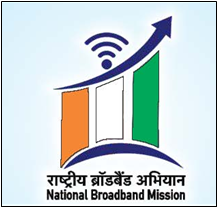
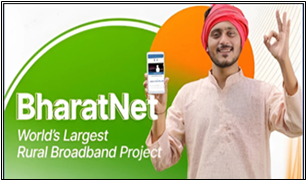
BharatNet
A cornerstone of rural connectivity is BharatNet, being implemented in a phased manner to provide broadband connectivity to all Gram Panchayats (GPs) and villages beyond GPs on demand basis across the country. Phase I, completed in December 2017, focused on connecting 1 lakh Gram Panchayats. Phase II expanded coverage to an additional 1.5 lakh GPs using optical fibre, radio, and satellite technologies. The Amended BharatNet Program (ABP) aims for Optical Fibre (OF) connectivity to GPs in ring topology and OF connectivity to the remaining non-GP villages on demand, including future-proofing the network by integrating 5G technologies and increasing bandwidth capacity.
Boost in Telephone and Broadband Connections
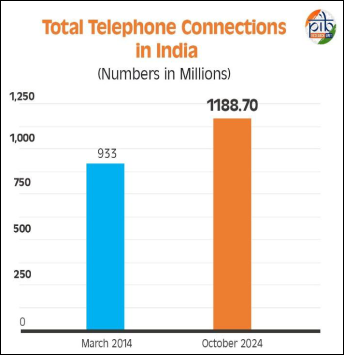
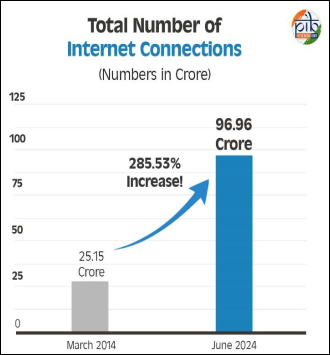
Total telephone connections in India grew from 933 million in March 2014 to 1188.70 million in October 2024. The overall tele-density in India which was 75.23 % in March 2014 rose to 84.49% in October 2024. Urban telephone connections rose to 661.36 million in October 2024 as compared to 555.23 million in March 2014 while rural telephone connections increased from 377.78 million in March 2014 to 527.34 million in October 2024.
Internet connections jumped from 25.15 crore in March 2014 to 96.96 crore in June 2024, registering a growth of 285.53%. Broadband connections rose from 6.1 crore in March, 2014 to 94.92 crore in August, 2024 growing by 1452%.
Common Service Centres (CSCs)
Complementing this infrastructure push are Common Service Centres (CSCs), which act as access points for delivering essential public utility services, social welfare schemes, healthcare, financial, education, and agriculture services. CSC e-Governance Services India Limited (CSC-SPV) was assigned to provide last-mile connectivity in GPs through Wi-Fi Access Points and FTTH connections under BharatNet.
Emerging Technologies and Other Digital Initiatives
Use of Immersive Technologies (AR/VR) in the Broadcasting Landscape
Technologies like augmented reality (AR), virtual reality (VR) and mixed reality (MR) can revolutionize content creation and consumption in broadcasting. Experts from broadcasting domain alongside technology innovators presented the use cases to highlight how immersive technologies can enhance viewer engagement, create richer experiences and reshape the future of media content delivery.

D2M and 5G Broadcasting[1]
New Direct to Mobile (D2M) technologies offer exciting content possibilities for terrestrial broadcasting not only to television but also on handheld devices- Mobile phones, pads etc on anywhere, any time basis, and that too without the need of Internet. Exploration of innovative options of broadcasting like Next Gen broadcasting not only ensures wider reach to cater to all strata of our society but also serve as a catalyst for ever evolving user experience. The two major technological standards namely ATSC 3.0 and 5G broadcasting (based on 3GPP standard) to facilitate the seamless direct reception of content to mobile handsets, potentially transforming how users’ access and consume media. [2]
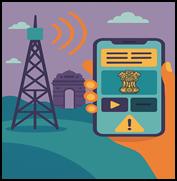
PM- WANI
The Prime Minister's Wi-Fi Access Network Interface (PM-WANI) framework is a key initiative aimed at expanding internet access across India by establishing public Wi-Fi hotspots. Its primary goal is to advance the vision of a Digital India and unlock the associated socio-economic benefits. Under this framework, Public Data Offices (PDOs) are responsible for setting up, operating, and maintaining WANI-compliant Wi-Fi hotspots based on their own technical and commercial strategies. To provide internet services to users, PDOs must collaborate with a Public Data Office Aggregator (PDOA). As of March 20, 2025, a total of 2,78,439. PM-WANI Wi-Fi hotspots have been deployed across the country. PM-WANI-compliant Wi-Fi hardware is widely available in the market. According to the Centre for Development of Telematics (C-DOT), such hardware is also distributed through C-DOT’s Transfer of Technology (ToT) partners, ensuring ease of access for service providers.

Sanchar Saathi
The Sanchar Saathi Mobile App is a user-centric platform aimed at enhancing telecom security and empowering citizens. The Sanchar Saathi Mobile App, available on Android and iOS, equips users with essential tools to safeguard their telecom assets and prevent fraud, offering features like reporting suspected fraud communications, managing mobile connections, blocking lost or stolen devices, and verifying handset authenticity. With over 90 crore smartphone users in India, the app ensures easy access to these critical services through a simple, user-friendly interface.
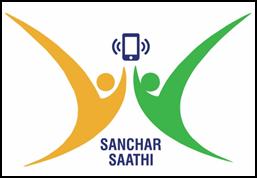
Empowering Women through Digital Technologies: India's Initiatives
Aligning with the global focus on digital empowerment for women, India has launched several targeted programs:
Mahila E-Haat
It is an initiative for meeting aspirations and needs of women entrepreneurs. It is an online marketing platform for women, where participants can display their products. It is an initiative for women across the country as a part of ‘Digital India’ and ‘Stand Up India’ initiatives. The platform has been set up by the Ministry of Women and Child Development, Government of India under Rashtriya Mahila Kosh (RMK).
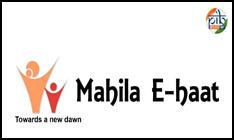
Pradhan Mantri Gramin Digital Saksharta Abhiyan (PMGDISHA)
Launched in February 2017 with the approved budget outlay of Rs. 2351.38 crore[3], to enhance digital literacy in rural areas, PMGDISHA aimed to empower one person from each of the 6 crore rural households with basic digital skills. The scheme concluded on March 31, 2024, having successfully trained 6.39 crore individuals. Notably, as of December 8, 2022, over 53% of those enrolled, over 54% of those trained, and over 56% of those certified under PMGDISHA were women.

Conclusion: Towards an Inclusive Digital Future
India's commitment to closing the digital gender gap was strongly reflected during its G20 presidency, where leaders pledged to halve the gap by 2030. With a robust Digital Public Infrastructure (DPI) enabling financial inclusion through Direct Benefit Transfers (DBT) and Government-to-Person (G2P) payments, especially for rural women, India is advancing gender equity in the digital space. As the telecommunications sector evolves, ensuring digital inclusion for women remains essential to achieving gender equality and enabling their full participation in the digital economy. The observance of World Telecommunication and Information Society Day 2025 highlights both the strides made and the ongoing need to build a truly inclusive digital future where women and girls have equal access to opportunities to connect, learn, and succeed.
References
https://www.un.org/en/observances/telecommunication-day
https://www.pib.gov.in/PressReleaseIframePage.aspx?PRID=2006304#:~:text=New%20Direct%20to,evolving%20user%20experience.
https://www.pib.gov.in/PressReleasePage.aspx?PRID=2065735#:~:text=The%20second%20session%2C%20'D2M%20and,@trai.gov.in.
https://www.pib.gov.in/PressReleasePage.aspx?PRID=2086701
https://www.pib.gov.in/PressReleasePage.aspx?PRID=2108690
https://www.pib.gov.in/PressReleasePage.aspx?PRID=1957411
https://www.pib.gov.in/PressReleasePage.aspx?PRID=1882218
https://egovernance.vikaspedia.in/viewcontent/e-governance/women-and-e-governance/mahila-e-haat?lgn=en
https://www.pib.gov.in/PressReleasePage.aspx?PRID=2093732
https://www.pib.gov.in/PressReleasePage.aspx?PRID=2115285#:~:text=The%20Prime%20Minister's%20Wi%2DFi,India%20and%20consequential%20benefits%20thereon.
https://www.pib.gov.in/PressReleasePage.aspx?PRID=2065992
https://www.pib.gov.in/PressReleasePage.aspx?PRID=2065735
https://wcdhry.gov.in/women-helpline-number-181/
https://www.pib.gov.in/PressReleseDetailm.aspx?PRID=1843847
Click here for pdf file.
****
Santosh Kumar | Ritu Kataria | Chaitanya Mishra | Priya Nagar
(Backgrounder ID: 154482)
Visitor Counter : 3731
Provide suggestions / comments